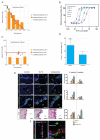An integrated in vitro and in vivo high-throughput screen identifies treatment leads for ependymoma
- PMID: 21907928
- PMCID: PMC3172881
- DOI: 10.1016/j.ccr.2011.08.013
An integrated in vitro and in vivo high-throughput screen identifies treatment leads for ependymoma
Abstract
Using a mouse model of ependymoma-a chemoresistant brain tumor-we combined multicell high-throughput screening (HTS), kinome-wide binding assays, and in vivo efficacy studies, to identify potential treatments with predicted toxicity against neural stem cells (NSC). We identified kinases within the insulin signaling pathway and centrosome cycle as regulators of ependymoma cell proliferation, and their corresponding inhibitors as potential therapies. FDA approved drugs not currently used to treat ependymoma were also identified that posses selective toxicity against ependymoma cells relative to normal NSCs both in vitro and in vivo, e.g., 5-fluorouracil. Our comprehensive approach advances understanding of the biology and treatment of ependymoma including the discovery of several treatment leads for immediate clinical translation.
Copyright © 2011 Elsevier Inc. All rights reserved.
Figures







References
-
- Adams J. The proteasome: a suitable antineoplastic target. Nat Rev Cancer. 2004;4:349–360. - PubMed
-
- Alsarra IA, Alarifi MN. Validated liquid chromatographic determination of 5-fluorouracil in human plasma. J Chromatogr B Analyt Technol Biomed Life Sci. 2004;804:435–439. - PubMed
-
- Baker KL, Daniels SB, Lennington JB, Lardaro T, Czap A, Notti RQ, Cooper O, Isacson O, Frasca S, Conover JC. Neuroblast protuberances in the subventricular zone of the regenerative MRL/MpJ mouse. The Journal of Comparative Neurology. 2006;498:747–761. - PubMed
-
- Berry DA, Cronin KA, Plevritis SK, Fryback DG, Clarke L, Zelen M, Mandelblatt JS, Yakovlev AY, Habbema JD, Feuer EJ. Effect of screening and adjuvant therapy on mortality from breast cancer. N Engl J Med. 2005;353:1784–1792. - PubMed
Publication types
MeSH terms
Substances
Grants and funding
LinkOut - more resources
Full Text Sources
Medical

